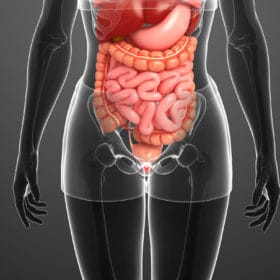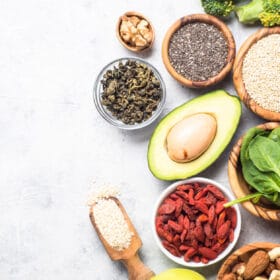It is no secret that the success of training, regardless of whether it is about building lean muscle or the clean breakdown of depot fat, depends primarily on nutrition. However, especially in the area of nutrients, numerous mysteries persist that present training beginners in particular with a mammoth task. However, many advanced athletes feel overwhelmed by the biochemical interrelationships of the various nutrients, so that considerable performance potential is lost. So that you keep the overview and find your way in the jungle of the Micro and macronutrients we have put together a guide that will enable you to optimize your nutrient supply and thus get the most out of your body.
How do micronutrients and macronutrients differ?
In nutritional science, macronutrients are generally defined as nutrients that are primarily used by the human body to produce energy, but also have other important functions, such as building new tissues and synthesizing essential hormones. To the Macronutrientswhich every animal creature, including humans, needs, include the following Carbohydrates, proteins and fats. Some sports and nutrition scientists continue to add water to the macronutrients, as this is by far the most important nutrient for our body. Mostly, however, the subject complex of hydration is considered separately. Micronutrients on the other hand, must be taken in through food just like macronutrients, but they are not used for energy production, but are primarily responsible for other metabolic processes, such as strengthening the immune system, hormone production or maintaining the diffusion-based processes in the human body. A deficiency of micronutrients essential for survival such as. Vitamins, minerals or trace elements can be life-threatening, especially if it persists for a long time.
Carbohydrates - the fuel that powers us
Even though the intake of carbohydrates, unlike that of proteins and fats, is not essential for survival, they are the most important energy source in the human metabolism, which the human body uses preferentially for energy production in terms of muscle work. Carbohydrates are characterized by an energy density of about four kilocalories per gram as well as their direct influence on the insulin level, which significantly determines both the anabolic and the catabolic metabolism. In nutritional science, a distinction is made between monosaccharides, disaccharides, polysaccharides and polysaccharides, depending on the length of a carbohydrate or sugar molecule. The simpler the structure of a molecule, the faster the body is able to obtain energy from it. The energy obtained from short-chain carbohydrates such as fructose or granulated sugar is available immediately, but it causes significant spikes in insulin levels, which leads to a short-term increase in performance, but is followed by a physical and mental low. In contrast, long-chain carbohydrates, such as those found in whole grain products or vegetables, are characterized by their long holding time. In this context, the energy is released evenly over a longer period of time, which not only enables the constant maintenance of athletic performance, but also leads to a longer-lasting satiety effect. Thus, both long-chain and short-chain carbohydrates have their raison d'être in the field of sports nutrition.
Proteins - the building blocks of the human body
Like carbohydrates, proteins have a calorific value of a good four kilocalories per gram, but the organism uses them only in very small quantities for energy production, since it prefers carbohydrates and fats as short- and long-term energy sources. Nevertheless, proteins are directly involved in energy metabolism, since the breakdown of carbohydrates and fats requires, among other things, enzymes and transport proteins that are synthesized from amino acids. Accordingly, proteins consist of an individual combination of the twenty amino acids known to sports science, eight of which are essential, i.e. cannot be synthesized by the organism itself. All other amino acids can be produced by the body itself from the eight essential ones. One of the most important tasks of proteins is to build new cells, such as muscle, skin or nerve cells. Proteins are of particular importance in the area of DNA replication, without which the formation of new tissue as a result of cell division would not be possible. Accordingly, an inadequate supply of protein leads to considerable metabolic disorders which, if this condition persists over a longer period of time, can assume life-threatening proportions. For athletes, however, the fact is that the organism has a significantly higher protein requirement than that of the average person due to the significantly higher demands placed on it. Consequently, the consumption of 1.5 to 2 grams of protein per kilogram of body weight per day is recommended. In this context, care should be taken to use high-quality protein sources such as lean meat, fish, dairy products, as well as nuts and legumes.
Fat - More than just a macronutrient
Fats do not serve the body exclusively as an excellent source of energy, although at 9.1 kilocalories per gram they have the highest energy density among the macronutrients. Just like proteins, fats are among the essential nutrients without which the organism could not function in its entirety, because both hormone production and the digestion of fat-soluble vitamins would simply not be possible without fats. Fats are subdivided into saturated and unsaturated fatty acids, each of which has different properties and tasks and is therefore indispensable for the human metabolism, even if the myth "fat makes you fat" still persists in this context. Saturated fatty acids and monounsaturated fatty acids are used by the body primarily for energy production during aerobic endurance exercise. Polyunsaturated fatty acids generally form the basis for hormone production and thus have an indirect influence on anabolic and catabolic metabolism. In the daily diet, the focus should be primarily on consuming healthy saturated fatty acids, as contained in palm fat, as well as monounsaturated and polyunsaturated fatty acids from nuts, oils and fish, in order to guarantee an optimal supply. In particular, omega-3 fatty acids, such as those found in fatty sea fish, should not be skimped on, as they strengthen the immune system and inhibit inflammatory processes in the body. In sports science, the recommendation that between 0.8 and 1 gram of fat per day is necessary to adequately supply an average athlete has become established.
Minerals ensure a balanced metabolism
Minerals form the first large group of micronutrients and are characterized by the fact that they are inorganic compounds that are absolutely needed by the human body to maintain metabolism. Although they are not utilized energetically, they play an essential role, among other things, in the regulation of the water balance, the transmission of stimuli in the nervous system, and the proper functioning of the heart. The most important minerals include the so-called blood salts, the electrolytes, which include sodium, potassium, magnesium as well as calcium and chloride. Since minerals are excreted mainly through sweat, their supply through food is necessary, especially during and after sweaty workouts, to avoid undersupply. Sodium and potassium regulate the body's water balance and are also necessary to ensure muscle contraction. A deficiency of one of these minerals becomes noticeable early on in the form of a sharp decline in strength and strength endurance performance. Magnesium strengthens the immune system, prevents cramps and improves the oxygen supply to the cells, while calcium, which is mainly found in dairy products, and phosphorus support muscle contraction and ensure strong bones and teeth. Sulfur, which is also an essential mineral and is found mainly in meat, nuts and vegetables, regulates blood sugar levels and contributes to the detoxification of the body.
Trace elements and secondary plant substances
Trace elements are metals or metalloids that are found only in small quantities in the human organism, but are absolutely necessary for its functioning and must therefore be supplied regularly through the diet. Trace elements such as zinc, iron, fluorine, selenium, copper, iodine, manganese and chromium must not be missing in a balanced diet. Zinc, for example, ensures sufficient production of the hormones testosterone and insulin and also supports enzymatic metabolic processes. Iodine, which is primarily found in iodized table salt, sea fish and vegetables, is responsible for the formation of the thyroid hormone, without which energy production in the mitochondria of the cells could not take place. Secondary plant compounds, on the other hand, are currently less thoroughly researched than trace elements, yet scientific proof has already been provided that they reduce the risk of cancer, promote digestion and positively influence cholesterol levels, among other things. Excellent sources of phytochemicals are primarily green-leaved vegetables, legumes and allium plants such as garlic and leeks. Thus, both trace elements and secondary plant compounds should not be underestimated in their importance and should therefore be supplied through a balanced diet.
Vitamins
Just like minerals, trace elements and secondary plant substances, vitamins are also classified as micronutrients. These vital substances are also not available to the body as energy carriers, but must be supplied in sufficient quantities regardless of this fact, since they are involved in numerous metabolic processes that are essential for survival and the organism cannot produce them in sufficient quantities on its own. Vitamins are divided into water-soluble and fat-soluble vitamins. Vitamins A, D, E and K belong to the lipophilic (fat-soluble) vital substances, whereas vitamin C and the entire vitamin B complex belong to the hydrophilic (water-soluble) vitamins. A deficiency of vital substances can have numerous devastating consequences for the human body. Examples of such phenomena caused by an insufficient supply of vitamin C are muscle weakness, states of exhaustion and frequent inflammation of the joints. To prevent deficiency symptoms, the Society for Nutrition recommends a daily intake of 150 milligrams, which can already be covered with a large glass of orange juice. The same applies to most of the other vitamins, whose requirements can also be met with a balanced diet. Only vitamin D, which the body can only synthesize with the help of UV radiation, should be taken in additionally through supplements, at least during the dark season, since a vitamin D deficiency has been proven to weaken the body's defenses and thus affect athletic performance.
Micro and macro nutrients are important
Macronutrient intake is undoubtedly the basis for energy metabolism in humans and should therefore be adapted to individual needs, especially when it comes to building muscle or reducing body fat. Nevertheless, micronutrients such as minerals, trace elements, vitamins and secondary plant compounds are essential for the human body. For this very reason, it is necessary that you pay attention to a balanced diet with plenty of fruits, vegetables, but also healthy animal foods, in order to also cover the need for micronutrients. Only a few micronutrients such as vitamin D should be supplemented, at least in our latitudes, in order to avoid deficiency symptoms and resulting performance losses.




